Spinel: A Description of Two Large Spinel Rubies
A DESCRIPTION OF TWO LARGE SPINEL RUBIES,
WITH PERSIAN CHARACTERS ENGRAVED UPON THEM
By
V. BALL, C.B., LL.D., F.R.S., Director of the Science and Art Museum, Dublin.
(Plate X.)
[Read January 22, 1894.]
Proceedings of the Royal Irish Academy, Third Series, Vol. 3, No. 3, pp. 380–400.
Editor’s Note: Continuing with our tradition of reproducing some of the nuggets from the literature of gems from bygone eras, we are proud to present this article from Dr. Valentine Ball. Many know Ball from his work in translating Tavernier’s Travels to India (Travels in India by Jean Baptiste Tavernier. London, Oxford University Press, 2 vols., 2nd ed. revised by W. Crooke, 335, 399 pp.). Ball was also head of the Geological Survey of India for many years. Note that we have added illustrations not present in the original.
For additional information on spinel, click the link below:
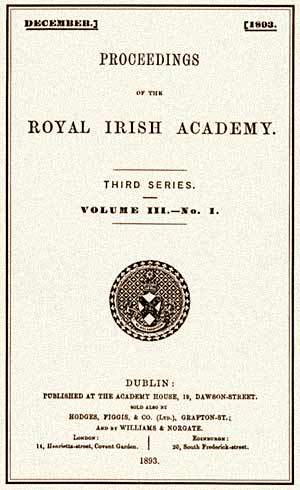 |
A
bout a year ago I was informed that Lady Carew possessed a precious stone, with inscriptions in Persian characters engraved upon it. Some months later I wrote to her ladyship on the subject, and she was so kind as to furnish me with sealing-wax impressions of the Persian characters, and she subsequently afforded me an opportunity of examining the stone itself, which proved to be a spinel ruby; she also permitted a careful model of it to be prepared. It was at the same time weighed, but, being mounted with gold attachment, the actual weight could only be estimated, and the specific gravity could not then be ascertained.
Though polished superficially, it is quite uncut, and is of an irregular pear shape. Upon four of its surfaces, respectively, the names or titles of four of the Mogul Emperors are engraved. Those facts led me to make a preliminary communication on the subject to the Athenaeum (No. 3454, 6th January, 1894). I now propose to recapitulate the facts with the further detail and illustration which such an opportunity as the present affords.
The history of the stone is, that it was purchased by Lady Carew’s grand-uncle, Mr. Charles Alison, C.B., H.M. Ambassador in Persia, from a merchant at Teheran, before the year 1870, say some twenty-five years ago. Having been brought to England, it was for a time placed in the hands of Messrs. Hunt and Roskell, the well-known jewellers of Bond-street, and by them I have been informed that its true weight is 133 1/2 carats, and they have fully confirmed the view that it is a spinel, by a further examination. Its dimensions are as follows:– length, 1.62 inches; maximum breadth, 9 inches. As w as the case with many other rubies and other precious stones of the period to which it belonged, it was bored through from end to end, to admit of its being strung on a chain or suspended as a pendant,1 and this means of suspension has been made use of in its present mount as a pendant from a necklace.
The four engraved names, to which reference has just been made, are as follows:–
(1). Akbar Shahi.2
(2). Shah Akbar, Jahangir Shah, 1021 (= A.D. 1612).
(3). Sahib Kiran Sani, 1039 (= A.D. 1629).
Sahib Kiran Sani signifies Second Lord of the (auspicious) conjunction (of the planets Venus and Jupiter). It was a title assumed by the Emperor Shah Jahan, having been borne first by his ancestor Timur. As we shall see, it was also used by Nadir Shah.3
(4). Alamgir Shah 1070 (= A.D. 1659).
Alamgir, or Lord of the Earth, was the title which Aurangzeb, who reigned from 1658 to 1707, conferred upon himself. In this case the last figure of the date is obscure or was never engraved, only the figures 107 can be read with certainty; but the smallest murk being the dot, for cipher, it has been adopted as the most likely figure to have been either obliterated or perhaps even taken as understood.
My thanks are due to Professor Mir Aulad Ali for the assistance he has given me in reading these inscriptions. Without his aid I should not have ventured on my own authority to publish them.
Before proceeding further with an account of this stone it will be convenient to describe another spinel ruby, which my inquiries from Messrs. Hunt and Roskell have, so to speak, drawn from previous oblivious. Not only was this firm so good as to send me a leaden model of it, which showed some indistinct traces of an inscription, but on the occasion of a visit which I subsequently paid to London they placed in my hands sealing-wax impressions taken from the original, which are perfectly legible and of considerable interest in themselves; but they possess an additional value from the fact that, about the year 1861, after the impressions were taken, the stone itself was cut down to form a rectangular-shaped jewel, and there is no other record of the original form and engraved characters at present extant. The weight of the stone, before cutting, was 197 carats, and in its reduced form it may, perhaps, be only about one-third of that amount. Its present possessor is not known. Messrs. Hunt and Roskell state that this stone was also a spinel.4
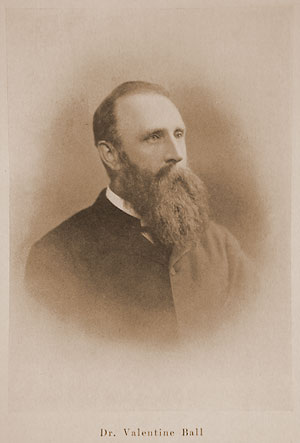 |
| Dr. Valentine Ball, author of the present paper and former head of the Geological Survey of India. From Ball, V. (1925) Travels in India by Jean Baptiste Tavernier. London, Oxford University Press, 2 vols., 2nd ed. revised by W. Crooke, 335, 399 pp. |
There were five separate inscriptions on it as follows:–
(1). Akbar Shahi, 1009 (= A.D. 1600).
(2). Shah Akbar, Jahangir Shah, 1016 (?) (= A.D. 1607).
This date is doubtful as regards the 6.
(3). Sahib Kirin Sani (i.e. Shah Jahan), 1044 (= A.D. 1634).
(4). Alamgir Shah (i.e. Aurungzeb), 1069 (= A.D. 1658).
(5). Bazu-band5 Shah Shahan.
Sultan Nadir Sahib Kiran.
Muntakhb Jawahir-Khana Hindustan.
“Armlet of the King of Kings, Sultan Nadir, Lord of the Conjunction. A selected piece from the Jewel-treasury of Hindustan.” There is no date to this triplet; it must, however, have been engraved between 1739, when Nadir looted Delhi, and 1747, when he was murdered at Khorassan.
The similarity in the titles on the two rubies has been made apparent above, in addition to which it may be mentioned that there is a considerable degree of similarity in the style of the engraving of the names, respectively, excepting only Akbar’s. This is sufficiently apparent in the transcripts (see Plate X.), although the two sets were reproduced by somewhat different methods–one by tracings from photographic enlargements, and the other by hand-copies. In making the former, as well as in the ingenious reproductions of the inscriptions on the models, from which he took the photographs from which the Plate has been prepared, I had the assistance of Mr. A. M’Googan, Technical Assistant in the Science and Art Museum.
HISTORICAL ENGRAVED RUBIES.
With the object of, if possible, tracing the past history of the two rubies under notice, it is necessary to consider some of the statements as to rubies in the Mogul’s and in the Shah’s treasuries and elsewhere, which have been recorded by writers.
An early notice of a monster ruby is to be found in “Elliot’s History of India,” vol. ii. App. 454. Haji Muhummud states that one weighing 450 mishkals (say about 10500 carats), the like of which had never been seen before, was obtained in the plunder of the temples of Thaneswar by Mahmoud of Ghazni, in the year A.H. 405 (A.D. 1011). This sounds like a fabulous weight.
I do not think it worth while to refer here to the exaggerated stories by Varthema, Marco Polo, and others, as to monster rubies in Burmah, Ceylon, &e., as they have no direct connection with the present subject.
The term “balass,” often used in the accounts of rubies, was derived originally from Balkh, in Badakshan, where there are ancient spinel-ruby mines. In my edition of Tavernier’s “Travels” I have dealt with the ascribed origins of this name, which is now applied by jewellers to rubies of a particular hue, not, exclusively at least, to spinels. There is reason for thinking that many of the large historical spinels, both of the East and Europe, may have come from the locality in Badakshan, or possibly even from Afghanistan, rather than from the better known localities of Ceylon and Burmah.
The following extract6 is one of the earliest references by a European to this region:–
Timur “caused all the Meerzas and nobles in the land of Samarcand to come to this festival; amongst whom was the lord of Baluxia, which is a great city7 where rubies are procured, and he came with a large troop of knights and followers.
“The ambassadors went to this lord of Balaxia, and asked him how he got the rubies, and he replied that near the city there was a mountain whence they brought them, and that every day they broke up a rock in search of them. He said that when they found n vein, they got out the rubies skilfully, by breaking the rock all round with chisels. During the work, a great guard was set by order of Timur Beg, and Balaxia is ten days journey from Samarcand, in the direction of India.”
The earliest notice of an engraved ruby appears to be by Josafa Barbaro,8 who about the year 1472, was shown a number of balass rubies, by the Shah (Uzun Hassan), among them being one fashioned like a date fruit, of good colour, bored through and weighing 100 carats. He also saw a string of twelve balasses “lyke unto olyves, of a very clene color, between 50 and 80 carrata a pece. Then took he out one sable balasse of two ounces and an halfe of a goodley facon, bigge as a fynger, without any hole and of excellent color, in the one corner thereof were certein Moresco l’res graven which moved me to aske what l’res they were and he answered me that a certain King had caused them there to be graven, syns which tyme neither his predecessor nor he wolde grave any more, because it shulde deface the whole.” Our author on being asked by the Shah the value of the balass ruby said it was worth a city, and he proceeds to say:
“This doon he shewed me a rubie of an ounce and an halfe, of the facon of a cheste nutte, rounde faire coloured, and clene; not bored through and bounde in a circle of gold, which seemed to me a mervallouse thinge, being so great, he shewed me after, many balasses both jewelled and unjewelled, amongst the which there was one in a square table made after the facon of a little nayle, rounde about the which were five other table balasses, the great one in the middest weying 30 carretts or thereabouts, and the next twenty carretts or thereabouts, betwene the which there were certein great perles and turcasses set, not of any great estimasion, for they were olde.”
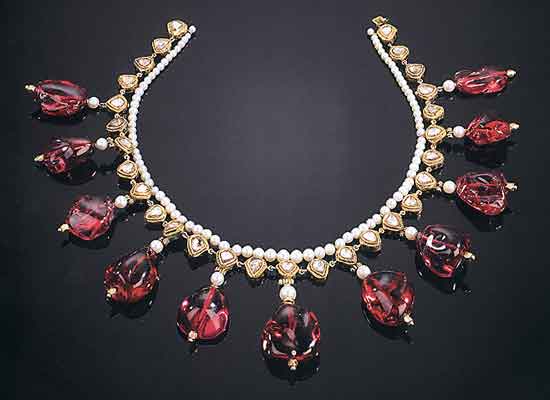 |
| This amazing spinel bead, pearl, and diamond necklace comprises eleven spinel beads weighing 877.23 carats. Three of the beads are engraved with the names of Akbar, Jahangir and Shah Jahan (builder of the Taj Mahal). The origin of these spinels is most likely the mines of Badakhshan, on the present-day border that separates Afghanistan and Tajikistan. This necklace (lot 419) was sold at auction at Christie’s in London on 8 October, 1997 for £881,500 (US$1,428,030). This most likely represents a world auction record for a single piece of spinel jewelry. Photo courtesy of Christie’s. From Christie’s London (1997) Important Indian Jewellery. Wednesday, 8 October, 1997, Catalog #5858. This necklace is now housed at the Museum of Islamic Art, in Doha, Qatar. |
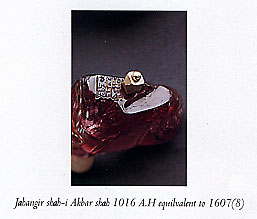 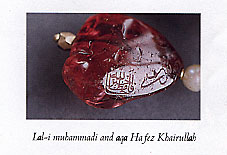 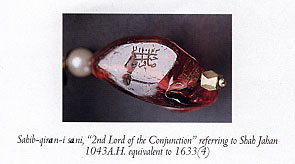 |
| Details of the engravings on the spinel beads from the above necklace. Photos courtesy of Christie’s. From Christie’s London (1997) Important Indian Jewellery. Wednesday, 8 October, 1997, Catalog #5858. |
At this time Behlol Lodi was Emperor of Hindustan, and it was not until eighty-four years later that Akbar came to the throne, viz. in 1556 But the facts are of importance, as they show that at this early date there were several large rubies in the Persian treasury.
It was probable one of these which Chardin described in 1666 as a monster ruby as big as a hen’s egg, and of the finest and deepest colour. It is said to have had the name Scheek Sephy (sic for Sheik Safvi) engraved upon it.9 He flourished in the fourteenth century, and was the progenitor of the Safvean dynasty.
In a native account10 of the completion of the Peacock throne by Shah Jahan in the year A.H. 1044 (=A.D. 1634), it is stated that, in the jewelled recess intended for the cushion forming the seat of the king, there was set “a ruby worth a lakh of rupees11 which Shah Abbas, the King of Iran, had presented to the late Emperor, Jahangir, who sent it as a gift to his present Majesty, the Sahib Kiran-i-sani, (i.e. Shah Jahan) when he accomplished the conquest of Dakhin. On it were engraved the names Sahib Kiran (Timur), Mir Shah Rukh12 and Mirza Ulug Beg.13 When, in course of time, it came into the possession of Shah Abbas, his name was added; and when Jahangir obtained it he added the name of himself, and that of his father (i.e. Akbar). Now it received the name of his Most Gracious Majesty Shah Jahan.
When in the year 1739, Muhammad Shah bestowed upon Nadir Shah, “with his own magnificent hand,” says another native writer,14 the peacock throne there was set in it a ruby upwards of a girih (three fingers) in breadth, and nearly two in length (six fingers), which was commonly called Kiraj-i-alam, “tribute of the world.”
Dow,15 who obtained his information from native sources, gives the following account:–
“In the year 1635 great rejoicings were made upon the birth of the Prince (Suliman Sheko), and the Emperor, on the occasion, mounted a new throne made of solid gold, embossed with precious stones. The throne had been seven years in finishing, and the expense of the jewels only, amounted to twelve hundred and fifty thousand pounds of our money. It was afterwards distinguished by the name of Takht-i-taus, or the peacock throne, from having the figures of two peacocks standing behind it with their tails spread, which were studded with jewels of various colours to represent the life. Between the peacocks stood a parrot of the ordinary size, cut out of one emerald. The finest jewel in the throne was a ruby which had fallen into the hands of Timur when he plundered Delhi in the year 1398. Jahangir, with peculiar barbarity, diminished the beauty and lustre of the stone by engraving upon it his own names and titles; and when he was reproved for this by the favourite Sultana, he replied: ‘This stone will perhaps carry my name further down through time than the empire of the house of Timur.’”
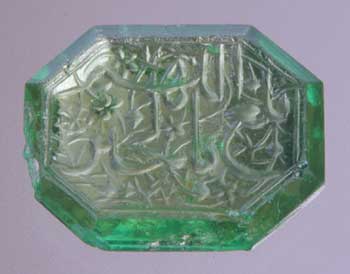 |
This Mughal-style engraved emerald was recently discovered by Palagems.com ex-webmaster Richard Hughes in a parcel of broken stones. The engraving reads “Please God, announce good tidings.” The writing is engraved in reverse, and can only be read correctly through the faceted side of the stone, since the stone was intended as a seal. Photo and translation courtesy of Maha Tannous, staff photographer/gemologist at the Gemological Institute of America, Carlsbad, California. |
The statement in this paragraph, and some other evidence which I have recently acquired, tend to show that the usually stated valuations of the jewels in the peacock throne are from five to ten times more than they should be; but I cannot enter into that question further on the present occasion. This “throne” ruby, as we shall see, subsequently became the property of Ranjit Singh.
The periods during which the above mentioned monarchs of Persia reigned were as follows:–Timur, 1402 to 1409; Shah Rukh Mirza, fourth son of Timur, 1409 to 1446; Ulug Beg, son of Shah Rukh, 1446 to 1449; Shah Abbas I., 1582 to 1627. The latter was an ally and friend of Jahangir. Even the taking of Kandahar did not, it is said, cause a serious rupture between them. It is uncertain whether the despatch of the ruby by Jahangir to Shah Jahan was in 1617–6 or not until 1625, as on both of these dates there was reconciliation and a passage of presents between father and son.
We next have Tavernier’s description and figure of a ruby belonging to Shah Abbas II. of Persia:– “It is of the thickness and shape of an egg, is bored through, and of very high colour, with the exception of a small flaw at the side. The custodians are unwilling to say what it cost… those who keep the registers of the Ring of Persia’s jewels merely say that this ruby has been in the possession of the King for many years.”16 The weight is given, with the figure, as 192 ratis. This would be equal to about 161 1/25th English carats. Apart from the discrepancy in the weight, the figure alone would suggest that this was the stone referred to by Barbaro above.
A figure of what may probably have been the largest of the stones mentioned by Barbaro, and subsequently by Chardin, has recently been made to do duty as the “Mogul’s diamond.”17 It certainly does not represent a facetted stone, but a huge cabochon, probably a ruby.
Sir William Jones records that Ali Kuli Khan, afterwards called Adil Shah, the immediate but only temporary successor of Nadir Shah, before Shah Rukh was installed, had the treasures left by Nadir transported from Kelat to Meshed, where he distributed a portion of them to great and small, without limit; he dispensed the purest silver like common corn, and the most precious stones like pebbles and glass. Subsequent revolutions and thefts served to further distribute them.18
Recent visitors to Persia19 mention a large ruby on the crown of Persia as having belonged to Aurangzeb. It may be so, but the evidence connecting it with him is not recorded, and one is tempted to suggest that it may really be one of the stones above mentioned, which date back to two centuries or more before Aurangzeb’s time.
Aurangzeb’s name is, however, definitely connected in history with a ruby. As I have elsewhere related,20 Shah Rukh, the grandson of Nadir Shah, was oppressed by Mir Alum Khan, who tried to force him to give up the Koh-i-nur diamond. It passed, however, into the hands of Ahmad Shah, the then King of Kabul, who came to Shah Rukh’s assistance in the year 1751, and he took it with him to Kabul. But Shah Rukh still retained other jewels (including the original peacock throne?) which had belonged to Nadir Shah, and these (about 1796), excited the cupidity of the eunuch Aga Muhammad Khan, who had already, from various sources, amassed many of the richest jewels brought by Nadir from Hindustan, which had, since his time, fallen into the hands of Lootf Ali Khan and sundry chieftains of Khorassan.
| One of the finest examples of a Badakhshan spinel is the Black Prince’s “Ruby”, a 140-ct. monster which is mounted in the front of the Imperial State Crown of Great Britain. It is on public display at the Tower of London. Photo: Younghusband, G. and Davenport, C. (1919) The Crown Jewels of England. London, Cassell and Co., 84 pp. |  |
Malcolm21 relates that:
“The blind Shah Rukh, who had long ceased to exercise power, was yet believed to possess many precious stones of great value, which he had concealed even from his sons. These were demanded by Aga Muhammad Khan; but he denied the possession of them, and took the most solemn oaths to persuade that monarch to credit the assertion; but in vain. Torture in all its forms was applied, and we almost cease to pity this degraded and miserable prince when informed that his discoveries kept pace with the pains which were inflicted upon him. Treasures and jewels were produced which had been sunk in wells and built up in walls; and at last, when a circle of paste was put upon his head, and boiling lead poured into it, he in his agony discovered a ruby of extraordinary size and lustre, which had once decorated the crown of Aurangzeb, and was the chief object of the search of Aga Muhammad. That monarch, we are informed (Persian MS.), the moment he heard that this jewel was found, expressed the greatest joy. He directed the tortures of Shah Rukh to cease.”
He died, however, soon afterwards from his injuries.
General Cunningham,22 in some remarks on the Koh-i-nur and Mogul diamonds, refers to a great ruby with Shah Jahan’s name upon it. He gives no reference to the source from which he quotes the statement, merely pointing out that the ruby was not noticed by Tavernier, but as his suggestion is that Tavernier mistook the histories of two stones, one being the Great Mogul diamond, it seems possible that “ruby” is a slip for diamond, and that the diamond with Shah Jahan’s name, to which reference is made on a subsequent page, was really intended in the passage. However, he may have referred to the ruby set in the throne which was presented to Jahangir by Shah Abbas I., and also bore Shah Jahan’s name, as stated above.
In the year 1813 Ranjit Singh forced Shah Shuja, then a suppliant for his aid and protection, to deliver up to him the Koh-i-nur; and he also, it is said, took from him many other precious stones and other treasures, and bought up some which the Shah been forced to dispose of to merchants in Amritsar. It is certain that he acquired, either by this means or otherwise, several of the jewels which had been taken from Delhi to Persia by Nadir Shah. Among the stones in Runjit Singh’s possession was an oriental topaz, possibly the one described by Tavernier as belonging to Aurangzeb. Murray,23 on what authority is not recorded, states that Ranjit had paid 20,000 rupees for it. The same author mentions that Ranjit possessed a ruby of considerable size with the names of several kings engraved upon it, including those of Aurangzeb and Ahmad Shah. Another account of this ruby, which is said to have considerably exceeded two tolas (= say, about 120 carats) in weight, is given in a manuscript history of Kashmir and the countries adjacent by Abdul Qadir of Benares, 1830. According to him the names of five emperors were engraved upon it.24
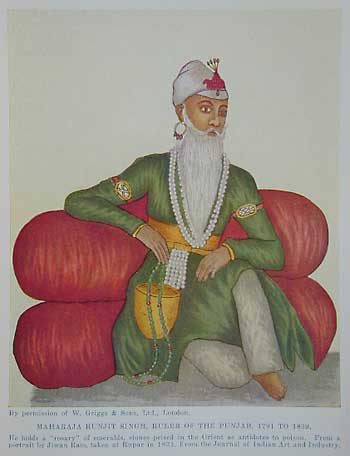 |
Ranjit Singh, “Lion of the Punjab.” He holds a rosary of emeralds, stones prized in the Orient as antidotes to poison. From a portrait by Jimwan Ram, taken at Rupar in 1831. Through his hands passed the Koh-i-Nur Diamond and Timur Ruby. When the British East India Company annexed the Punjab in 1849, they also annexed these famous gems. From Kunz, G.F. (1913) The Curious Lore of Precious Stones. Philadelphia, J.B. Lippincott, 406 pp. |
Lastly, Baron Von Hugel25 gives the following account, which identifies it with the stone set by Shah Jahan in the peacock throne. His quotation from Dow (see ante, p. 835) has suffered in the translation, first into German, and then back again into English:– “A pommel of one of the saddles struck me as particularly worthy of remark, having a ruby two inches square, bearing on it the name of Jahangir. Dow, in his ‘History of Hindostan,’ tells us that when Jahangir had his name engraved on this beautiful stone, the celebrated Empress Nur Jahan told him that she thought it a pity: to which he answered, ‘This jewel will more assuredly hand down my name to posterity than any written history. The house of Timur, may fall, but, as long as there is a king, this jewel will have its price.’ Many other names are now engraven on it, the best known being Ahmad Shah’s, who found it in the famous peacock throne (Takit-i-Taus), made by Shah Jahan in 1635 in Agra. This stone was stolen from Timur in the year 1398 at Delhi, and Jahangir repurchased it.” (The statements italicized are mistakes apparently due to a misreading of Dow).
The mention of Ahmad Shah (if the King of Kabul is meant) prevents the identification of this ruby with the one wrung from Shah Rukh by Aga Mahommed in 1796, as described above, for Ahmad could not have possessed that stone, as he died in 1773. Ahmad’s name, as we have seen, does not occur on either of the rubies now described, although Nadir’s does on one of them, but as we have a figure of this ruby of Ranjit’s by Miss Eden,26 it may be pointed out that, making allowance for the drawing possibly not being a close representation of the form, there is some resemblance between it and Nadir’s ruby, which has been above described, and has the names of four emperors and of Nadir engraved upon it. Ranjit’s ruby may very possibly have been sold in 1850, when the Koh-i-nur was sent to England, and the publication of this notice may perhaps lead to further information.
Miss Eden’s description, which accompanies the figure, merely says that “it is an uncut ruby on which some Persian characters were engraved.”
Schonberg speaks of an emerald (? mistake for ruby), on which several names were engraved, as being in the treasury at Lahore.27
I have recently been informed that there is a large engraved ruby, called the six-latch ruby, held in pledge for a debt by the Indian Government. It is, or was some years ago, lodged for safety in a bank at Lucknow. The name Sulaiman is said to be engraved on it.
Although it is not intended to mention here all the known engraved or carved rubies which are recorded, still it may be of interest to state that there are two small figures of Buddha carved out of a ruby and a sapphire, respectively, in the British Museum.
Rubies, too, have been cut into rings, thus:– “In the second year of his reign, Shah Jahangir was presented by Shaikh Farid-i-Bukhari with an immense ruby made into a ring, which weighed 1 misqua1, 15 surkhs, and was valued at 25,000 rupees.”28
Lord Auckland possessed an emerald ring engraved with Jahangir’s name in the year 1880.
A Burmese ambassador to Persia had a ring with him as a present from the King of Burmah for the Shah. Hoop, collot and all, were cut out of one solid and perfect ruby of the first water.29
I do not propose to enumerate here the large rubies which in the sixteenth, seventeenth, and eighteenth centuries, found their way to Europe; but there are many references to rubies of exceptional size in the writings by native authors, and among them the following:–
“Raja Rum Chand Bhath of Chunagarh presented Akbar (? A.H. 991) with a most valuable tribute of 100 rubies and other precious stones. The value of one of the rubies exceeded 50,000 rupees.”30
“In the year 1015 A.H. (160 A.D.) Asaf Khan presented a ruby to Jahangir (which his brother Abu-I-Qasim had bought for 40,000 rupees, and sent to him), as a pesh-kash, on his appointment as Wazir.”31
“In the year 1015 A.H. (1606 A.D.) Jahangir relates that he presented a ruby worth 25,000 rupees to his son Parwiz.32 ‘On the 21st of the same month I presented Parwiz with a necklace of four rubies and one hundred pearls.’”33
In the year 1616, according to Sir Thomas Roe, the Portuguese offered the Emperor Jahangir a balass ruby, weighing 13 tolas, or 5 1/5 oz. (= 783 carats), for 5 lakhs of rupees. He would only give one lakh for it.34
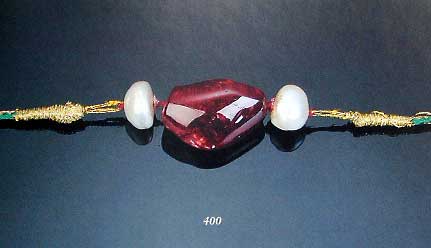 |
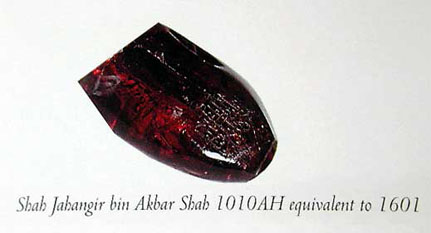 |
| An important antique spinel and pearl bazuband, with a central spinel bead weighing 79.55 cts, inscribed with the name of Jahangir and dated 1010 A.H. (1601 A.D.). The lower photo shows the detail of this piece. It sold at Christie’s London on 8 October 1997 for £62,000 (US$100,440). From Christie’s London (1997) Important Indian Jewellery. Wednesday, 8 October 1997, Catalog #5858. |
ENGRAVED DIAMONDS.
Not only were rubies engraved under the directions of the Mogul Emperors, but there are records of three diamonds having been marked with their owners’ names. The first was a diamond which weighed, it is said, about 116 carats, and was bought in Constantinople in the year 1866. It was recut, and sold to the late Gaikwar of Baroda for 31 lakhs of rupees. Its weight was then reduced to about 71 or 72 carats. Its original form and the inscriptions have, however, been preserved by models and impressions. The latter read as follows:–
(I.) Shah Akbar, Jahangir Shah, 1028 (A.D. 1618–19). Here Shah Akbar, as in the cases of the rubies, is honorific or expletive, and a prefix to the name Jahangir, within whose reign (1605–28) the diamond was therefore engraved. The style of the monogram is similar to those on the rubies.
(II.) The second inscription is Sahib Kiran Sani, 1039 (=A.D. 1629–30). This means the Second Lord of the Conjunction, a title by which Shah Jahan was known, as has already been explained.
At one time I was inclined to believe that this diamond might have been one which it is recorded Shah Jahan, then Prince Khurrum, obtained when he took refuge in Golconda, and sold to his father, Jahangir, for 1,000,000 rupees;35 but although the weights of both nearly correspond, being about 120 carats, the dates forbid the supposition, the date of the acquisition of the latter being said to be 1623–24; while that of the first engraving of the former was 1619, as has been just stated.
One published account of this diamond36 contains an extraordinary misreading of the inscriptions, although copies of the original characters are given with it, which can be easily deciphered. Needless to add, the deductions drawn are wholly erroneous as to the persons named; and the dates, too, are inaccurately given in A.D. equivalents.
The second engraved diamond is that known as the “Shah” which weighs 86 carats. It is in the Russian Treasury, having been presented to the Czar by the Shah of Persia in the year 1829 or 1830, when the son of the Crown Prince, Abbas Mirza, Prince Khusru, the younger, visited Russia. The names engraved upon it are said to be Akbar Shah, Nizam Shah, and Fath Ali Shah: no dates are mentioned in the published accounts of it.
It is possible that this stone did not descend to Akbar’s successors. It was, perhaps, given to him by one of the Nizam Shah’s on the conclusion of a treaty.37 Subsequently, it found its way to Persia, and became the property of Fath Ali Shah, who reigned from 1798 to 1834.
Most of the books on precious stones say that this remarkable prism-shaped stone was cut down from 95 to 86 carats after its arrival in Russia, and it has been suggested that, by this process, the engraved names have been removed. But the earliest authentic weight is given by Rose, as 86 carats,38 and the higher weight has, I think, got into the literature of the subject by a mistake. In all probability the engraved names are still on the stone.
The third engraved diamond is one called the Darya-i-nur, which is believed to be still in the Persian Treasury. Its weight was stated by Malcolm to be 186 carats, but other and higher weights have also been given by authors.39 I may mention that, through correspondents at Teheran, I have recently made two separate attempts to ascertain the true weight of this stone, and some other facts regarding the jewels now in the treasury there, but both have failed to elicit anything definite as yet. Even to make inquiries, I am informed, would arouse suspicions which might lead to inconvenient consequences. It is the case, too, that inquiries which I have presented about the Russian historical jewels, though favoured in a very special decree by the aid and sanction of high authority, have so far almost proved fruitless of the results hoped for.
The Darya-i-nur is said to be a flat table, 11/2 in. by 1 in. by 3/8 ths in. Another account with figures, by Kotzebue, makes the thickness much greater. It is said to have the name of Fath Ali Shah engraved upon it. Like the previously mentioned stones, it is reported by several authors, as Forbes and Eastwick, to have been taken from Delhi by Nadir Shah with the loot, of which jewels formed so large a portion. But there are reasons for thinking that possibly it did not form part of the Delhi loot, but may have reached Persia earlier.
The Darya-i-nur is often mentioned, and has been figured by Kotzebue,40 together with a companion stone called the Taj-e-Mah, otherwise sometimes called the Persian Koh-i-nur. In form the latter resembled Jahangir’s diamond very closely. According to Watson,41 these two diamonds were in the possession of Aga Muhammad, when he was murdered in 1797. Whether he had obtained them from Shah Rukh is not stated. They were given by the murderers to the General Sadek Khan Shekaki, and he subsequently made his peace with Fath Ali Shah, by handing them over to him.
If this be the case, then, this particular Darya-i-nur could not have belonged to Shah Shujah, but another stone, so called, probably from what Karim Khan42 relates about it, did so, and afterwards fell into the hands of Ranjit Singh.43 It is still also called Darya-i-nur, and is in the possession of the Nawab of Dacca at present. It is a flat stone measuring 11/4 in. by 1 in.; being mounted, its thickness and weight are not known, as I am informed by the owner. Its early history I have as yet been unable to trace fully, and further space cannot be given here even to what has been ascertained on the subject.
I have elsewhere44 ventured to suggest for consideration that the Persian Darya-i-nur, if it only weighs 186 carats, may, perhaps, be identical with Babar’s diamond which he gave to Humayon, and which has never since been referred to by contemporary authors as being in the possession of the Mogul Emperors, though it has been asserted that it must have descended to Humayon’s successors. But what appears to be more probable, perhaps, is, that Humayon himself took his diamond to Persia in the year 1540, when he had to fly from India, being driven out by Sher Shah, who succeeded him. He regained his throne only in the year 1555, and died in 1556.
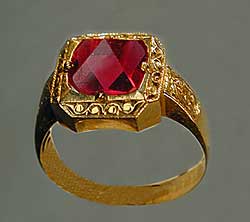 |
A Burmese spinel ring featuring a nat thwe (‘spirit polished’) spinel octahedron, which has received only light polishing. Photo: John McLean; Ring: William Larson Collection |
THE QUEEN OF DELHI’S ENGRAVED DIAMOND RING.
The diamond in this ring, which was recently offered for sale in London, is engraved with the words “Oh Ali”! It is said to have been in the possession of Maharajah Bhulwand Singh.
The ring is enamelled, and is described as a fine specimen of the best style of Indian workmanship.
There is nothing about it apparently to fix the date of the workmanship with any degree of certainty, though it has been suggested that the ring was made between 1550 and 1650, and the stone engraved much earlier.
From all these facts it would appear to have been a custom with the Mogul Emperors, Akbar and his successors, Jahangir, Shah Jahan and Aurangzeb, to have their names engraved on their jewels either on their succession or on some subsequent occasion, as fancy or the desire to commemorate particular events suggested.
This is otherwise borne out by such statements as the following:– “In the art of cutting carnelians Mulana Ibrahim is the pupil of his brother Sharaf of Yazd. He surpasses the ancient engravers: and it is impossible to distinguish his riqa and nasta’liq from the masterpieces of the best caligraphers. He engraved the words la’l jalali; or the glorious ruby, upon all imperial rubies of value.”45
It is said that Dara Sheko, instead of the sacred name of God, adopted the Hindu name Prabhu (Lord), which the Hindus consider holy, and he had his name engraved in Hindi letters upon rings of diamond, ruby, emerald, &e.46
It is a source of amazement to some persons to learn that diamonds have ever been engraved; but the phrase “diamond cut diamond” is merely founded on the fact which is exhibited in the ordinary cutting of diamonds by mutual attrition. Selected “hard” points can grave the surfaces of other diamonds with no great difficulty.
List of Recorded cases of Rubies and Diamonds engraved with the Names or Titles of the Mogul Emperors of India and the Shahs of Persia. Dates of engraving are added, so far as they are known.
RUBIES.
Shah’s (mentioned by Chardin):–
Sheik Safvi, 14th century.
Timur’s, or Throne:–
Timur (1402–1409).
Shah Rukh (King of Khorassan, 1397–1446)
Ulugh Beg (King of Samarcand, 1446–1449).
Akbar (Mogul Emperor, 1556–1605)
Shah Abbas (Shah of Persia, 1582–1627).
Jahangir (Mogul Emperor, 1605–l627)
Shah Jahan, Sahib Kiran Sani (Mogul Emperor, 1628–1658 ; A.H. 1044, A.D. 1634.
Aurangzeb, Alamgir Shah (Mogul Emperor, 1658–1707).
Ahmad Shah (King of Cabul, 1747–1773).
Lady Carew’s (1331/2 carats), in possession of Lady Carew:–
Akbar (Mogul Emperor, 1556–1605).
Jahangir (Mogul Emperor, 1605–1627); A.H. 1021, A.D. l612.
Shah Jahan, Sahib Kiran Sani (Mogul Emperor, 1628–1658); A.H. 1039, A.D. 1629.
Aurangzeb, Alamgir Shah (Mogul Emperor, 1658–1707); A.H., 1070, A.D. 1659–60:–
Nadir Shah’s (197 carats), has been recut; present owner not known:–
Akbar (Mogul Emperor, 1556–1605); A.H. 1009, A.D. 1600.
Jahangir (Mogul Emperor, 1605–1627); A.H. 1016 (?), A.D. 1607.
Shah Jahan, Sahib Kiran Sani (Mogul Emperor, 1628–1658); A.H. 1044, A.D. 1634.
Aurangzeb, Alamgir Shah (Mogul Emperor, 1658–1707; A.H. 1069, A.D. 1658–9.
Nadir Shah (Shah of Persia, 1736–1747).
| This important 17th Century carved emerald and diamond brooch is a lovely example of the Mogul style of gem engraving. The emerald weighs approximately 126 carats. It was sold at auction (lot 387) at Christie’s in London on 8 October, 1997 for £166,500 (US$269,730). Photo courtesy of Christie’s. From Christie’s London (1997) Important Indian Jewellery. Wednesday, 8 October, 1997, Catalog #5858. | 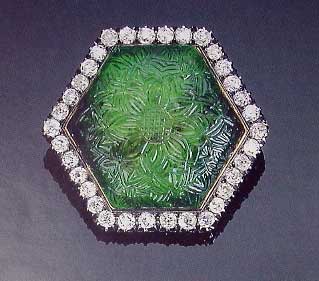 |
DIAMONDS.
The “Shah” (86 carats), belongs to Russia:–
Akbar (Mogul Emperor, 1556–1605).
Nizam Shah (dynasty lasted 1490–1636).
Fath Ali Shah (Shah of Persia, 1798–1834).
Jahangir’s (116 carats); reduced, by cutting, to 71 or 72 carats, and sold to Gaikwar of Baroda:–
Jahangir (Mogul Emperor, 1605–1627) A.H. 1028, A.D. 1619.
Shah Jahan, Sahib Kiran Sani (Mogul Emperor, 1628–1658) A.H. 1039, A.D. 1629.
Darya-I-nur (186 carats, ?); belongs to Shah of Persia:–
Fath Ali Shah (Shah of Persia, 1798–1834).
The deductions to be drawn from the names and dates in the preceding list are as follows:–Akbar’s name was engraved on the “Shah” diamond on Timur’s (or the Throne) ruby, and on Lady Carew’s ruby without any accompanying dates so far as is known. It was also engraved on what we call Nadir Shah’s ruby in A.H. 1009 (=A.D. 1600). Another name engraved on the “Shah” diamond was that of the Nizam Shah, so that probably it was taken from or conferred upon him by Akbar and was subsequently taken to Persia, not necessarily by Nadir, but on some previous occasion, perhaps a century before his time. Then about the beginning of this or the end of the last century, it was engraved with the name of the then ruling monarch of Persia, Fath Ali Shah. Thus it was possibly never in the possession of any of Akbar’s successors, the Mogul Emperors, as has been already suggested.
I have long had in preparation the full histories of the “Shah,” and many other Indian diamonds: here it need only be said that this one was presented to the Czar Nicholas of Russia in the year 1829 or 1830, by Prince Khusru in deprecation of his anger at the murder of his ambassador at Teheran.
Jahangir’s name with the honorific prefix “Shah Akbar,” and in a very similar style of monogram engraving, is dated as follows on:–
Nadir Shah’s ruby, A.H. 1016 ? (A.D. 1607).
Lady Carew’s ruby, A.H. 1021. (A.D. 1612).
Jahangir’s diamond, A.H. 1028. (A.D. 1619).
Jahangir’s name was also, as we have seen, engraved on the ruby which he gave to Shah Jahan, who had it mounted in the peacock throne. Unless the names of Timur and others which were upon it were subsequently deleted, it cannot be identified with Nadir Shah’s ruby.
The question arises have the dates any meaning, and can they be connected with any historical events.
Jahangir succeeded Akbar in 1605; and I have failed to find any plausible reason why the engraving on the rubies was deferred, as both presumably,47 and the one which is dated, almost certainly, descended to him from Akbar. The diamond, though not the one referred to on p. 391, may still have been acquired through Prince Khurum (i.e. Shah Jahan), when he was first in Golconda, about 1617, and may have been engraved on the completion of its cutting. I can find no particular events recorded as having taken place on the above dates.
Shah Jahan, who is in each case indicated by his title Sahib-Kiran Sani, or Second Lord of the Conjunction, caused the diamond and one of the rubies (Lady Carew’s) to be engraved in A.H. 1039 (=A.D. 1629). The other ruby (Nadir Shah’s) was engraved and dated A.H. 1044 (= A.D. 1634–5).
The first date was the year after his accession; and the second was notable as being that of the completion of the Peacock throne.
Shah Jahan also had his name engraved on Timur’s ruby, which he caused to be set in the Peacock throne, and that, as we have seen, unless some of the names were afterwards deleted, was a distinct stone.
Whether the diamond known as “Jahangir’s” ever reached the possession of Aurangzeb is not recorded; it was not seen by Tavernier, and it did not bear any inscription later than Shah Jahan’s. It first came to light, of late years, in Constantinople in the year 1866. It has since been cut, and was reduced in weight from 116 to 72 carats. It was then sold to the Gaikwar of Baroda.
Aurangzeb in the year 165848 assumed the title Alamgir, and that is the title which appears on these two rubies. Nadir Shah’s ruby is distinctly marked 1069, i.e. A.D. 1658–59, the year of Aurangzeb’s accession, when he deposed his father.
Lady Carew’s ruby has the figures 107, which may be taken to indicate 1070, or A.D. 1659–60 the year, or the year following, of Aurangzeb’s formal proclamation.49
Now this matter is not altogether a small or insignificant one, because it is known that Shah Jahan, when dethroned by his son, retained with him, in his prison, a large number of jewels which did not come into Aurangzeb’s possession till 1666, when, on the death of Shah Jahan, they were handed to him in a gold basin by his sister, Jahanara Begum, who accompanied the transfer by some rather uncomplimentary remarks on his past proceedings.
The Great Mogul diamond, or Koh-i-nur, and the other jewels described by Tavernier, were, of course, not among these last, and one certainly, and the other of these rubies probably, came into Aurangzeb’s hands, at or about the time of his accession, and were soon afterwards engraved.
This is all I have been, as yet, able to deduce from these dates, and names “graven in stone.” Had all the famous stones been similarly engraved, there would have been less room for discussion as to their antecedents, than there now is. On the other, hand the process of engraving on the prominent faces of large stones cannot but have depreciated their values to a very considerable degree. Be this as it may, Jahangir’s prophecy, quoted on a previous page, has in a measure come true, and it may be hoped that hereafter no stone still bearing these great names, will ever, as some have been in the past, be re-cut, and their dates obliterated.
[Note, &c.
NOTE ADDED IN THE PRESS.
While these pages were passing through the Press, I paid a visit to the India Office in Whitehall, and took the opportunity of examining the life-size oil-paintings of the Shahs of Persia which are preserved there. Most unexpectedly I found among them one of Nadir Shah, by an unknown native artist. It represents, with minute fidelity, his jewels; and on the left arm, high up, there is a bazu-band, the central jewel of which is a ruby whose form justifies the belief that it is the very one the history of which has been rescued from complete oblivion by the preservation of the sealing-wax impressions, of which the readings are given above, and in the accompanying Plate.
 |
Fig. I. Nadir Shah’s Spinel Ruby. (197 carats.) 1. Akbar Shahi, 1009. 2. Shah Akbar Jahangir Shah, 1016. (?) 3. Sahib Kiran Sani, 1044. 4. Alamgir Shahi, 1069. 5. Bazu band, Shah Shahan. Sultan Nadir Sahib Kiran. Muntakhb Juwahir Khana, Hindustan. Fig. II. Lady Carew’s Spinel Ruby. (1336 carats.) 1. Akbar Shahi. 2. Shah Akbar, Jahangir Shah, 1021. 3. Sahib Kiran Sani, 1039. 4. Alamgir Shahi, 107. |
- The custom of boring precious stones was common in the East; it is referred to by Tavernier; and Manouchi mentions that Akbar sent some splendid rubies to Goa, on which he desired to raise money for the expenses of the war in Gujarat; but, as these rubies were bored, no purchaser could be found for them.(back to text)
- Shahi is the possessive form of Shuh.(back to text)
- According to the Tuzuk-i-Jahangiri, translated by W.H. Lowe, Calcutta, 1889, pp. 90, 91, the title was even used occasionally by Jahangir. As Shah Jahan claimed to be the ‘second,’ and Timur was admittedly the ‘first,’ Jahangir’s use of it must have been ignored by his son.(back to text)
- In order to estimate the sp. g. of the original stone, I have compared its weight with that of the leaden model, and its sp. g. The ruby weighed 197 carats, or 40.66 grams, from which it may be deduced that the stone was most probably spinel, thus– 40.66 x 8.928 (sp. g. of model) ÷ 107.10 (weight of model) = 3.37, rather low, indeed, for spinel, but far too low for corundum.(back to text)
- In Persia, the Bazu-band or armlet often contains a talisman.(back to text)
- Embassy of Ruy Gonzalez de Clavigo to the Court of Timour at Samarcand, A.D. 1403–6. See Hak. Soc., p. 162. (back to text)
- In the remote mountains of Badakshan there are the richest known mines of rubies and lapis-lazuli. (back to text)
- “Travels to Tana and Persia,” edited by E. D. Morgan and C.H. Coote; see Hak. Soc., 1873, pp. 53–60. (back to text)
- King, “Nat. Hist. Precious Stones,” 1870, p. 237, Enault, “Les Diamants de la Couronne”: Paris, 1884, p. 84. (back to text)
- Badshah Nama of Abdul Hamid Lahori; Elliot, History of India, vol. vii., pp. 45, 46. (back to text)
- The value of a lakh of rupees at the time was about £11,250. (back to text)
- Shah Rukh Mirza, 4th son of Timur, died (aged 71) in 850 A.H. (= 1446 A.D.) (back to text)
- Ulug Beg, son of Shah Rukh and grandson of Timur, born at Sultanieh, 796 A.H. (1393 A.D.) Published his Astronomical Tables, A.H. 841 (1437); slain, 859 A.H. (= 1437 A.D.) See “Ain i Akbari,” Calcutta, by Col. Jarret; 1891, p. 5. (back to text)
- Jauhar-I Samsam, Elliot, vol. viii., p. 89. (back to text)
- “History of Hindustan,” vol. iii., p. 140. London: 1812. (back to text)
- Tavernier’s “Travels,” Eng. ed. 1899, vol. ii., pp. 127, 449. (back to text)
- See Nature, Nov. 5, p. 6; and Dec. 10, p. 126, 1891. (back to text)
- “Hist. de Nadir Shah,” vol. ii., p. 127–8. (back to text)
- Viscount Pollington, “Half Round the World,” London, E. Mason, 1867, p. 231; Eastwick, “Journal of a Diplomat,” 1864, vol. ii., p. 118; Curzon. “Persia,” vol. i., p. 316. (back to text)
- “Tavernier’s Travels,” Eng. Ed., vol. ii., p. 414. (back to text)
- “History of Persia,” vol. ii., p. 200. (back to text)
- “Arch. Survey of India Rep.,” vol. ii., 1871, p. 390. (back to text)
- “A Memoir on the Diamond,” 1839, p. 71. (back to text)
- See Prinsep, “Oriental Accounts of the Precious Minerals,” Journ. A.S. Bengal, vol. I, 1832, p. 360 (back to text)
- “Travels in Kashmir and the Punjab,” London, 1845, p. 303. (back to text)
- “Portraits of the Princes and People of India,” pl. xiv. (back to text)
- “Travels in India and Kashmir,” Lond., 1853, vol. i., p. 322. (back to text)
- See Blochmann, “Ain i Akbari,” Calcutta, 1871, p. 414. (back to text)
- See Wills, “The Land of the Lion and Sun,” Lond. 1883, p. 376. (back to text)
- “Tarikh-i-Badauni,” Elliot, “Hist. of India,” vol. v. p. 531. (back to text)
- See “Tuzuk-i-Jahangiri,” Calcutta, Lowe, 1889, p. 87. (back to text)
- See “Tuzuk-i-Jahangiri,” by Lowe, Calcutta, Bib. Ind. p. 63. (back to text)
- Id., p. 65. (back to text)
- See “Travels,” London, Trubner, 1873, p. 32. (back to text)
- Herbert’s “Travels,” London, 1677, p. 87. (back to text)
- “Great Diamonds” 1882, p. 210. (back to text)
- Akbar reigned from 1556 to 1605, and the Nizam Shahi Dynasty in India lasted from 1490 to 1636, it having been brought to an end by Shah Jahan, who, as well as his father Jahangir, possibly never possessed this stone. The Nizam Shah in this case may have been Bahadur Shah I. (back to text)
- “Reise nach dem Ural den Altai,” &e., Berlin, 1837, vol. i., p. 60. (back to text)
- Forbes, nearly 264 carats.–“Oriental Memoirs” (1781), vol. ii., p. 175. Kotzebue, 226 carats.–“Reise nach Persia” (1819), p. 182. Sir D. Brewster, 232 carats.–“North British Review” (1852), p. 217. (back to text)
- “Reise nach Persia,” 1819, p. 182, Pl. 9, and Eng. Transl. 1819, pp. 299, 300. (back to text)
- “A History of Persia,” 1866, p. 101. (back to text)
- “Hist. de l’Asie Centrale,” French trans. by C. Schafer, Paris, 1876; p. 67. (back to text)
- Schonberg, “Travels in India and Kashmir,” London, 1851, vol. i., p. 323. (back to text)
- Tavernier’s “Travels,” Eng. ed., 1889, vol. ii., p. 443. (back to text)
- Blochmann, “Ain i Akbari”, Calcutta, 1868, p. 53. (back to text)
- Muhammad Khazim in “Alamgir-nama.” See Elliot, vol. vii., p. 179. (back to text)
- Akbar’s name is engraved on the rubies, as we have seen, in the possessive form, Akbar Shabi. (back to text)
- Aurangzeb’s accession: “On the first Zil-ka-da., 1068 A.H. (22nd July, 1658, A.D.), after saying his prayers, and at an auspicious time, he took his seat on the throne of Hindustan, without even troubling himself about placing his “name on the coinage, or having it repeated in the khutba. Such matters as titles, the khutba, the coinage, and the sending of presents to other sovereigns, were all deferred to his second taking possession of the throne. “Khati Khan, Muntakhabu-I-Lubab,” vol. ii., p. 39: see “Elliot,” vol. vii., p. 229. (back to text)
- Aurangzeb’s proclamation. The second year of the reign commenced on the 4th, Ramazan, 1069, A.H. The Emperor’s name and titles were proclaimed in the pulpit as Abu-l-Muzaffar Muhiu-d din Muhammad Aurangzeb Bahadur’ Alamgir Badshah-i Ghazi. In former reigns one of the sides of the coins had been adorned with the words of the creeds and the names of the first four Khalifs; but as coins pass into many unworthy places, and fall under the feet of infidels, it was ordered that the superscription should be changed (for certain couplets containing the Emperor’s name). “Khafi Khan, Muntakhabu-l-Lubab,” vol. ii., p. 77: see: “Elliot,” vol. vii. p. 241. (back to text)
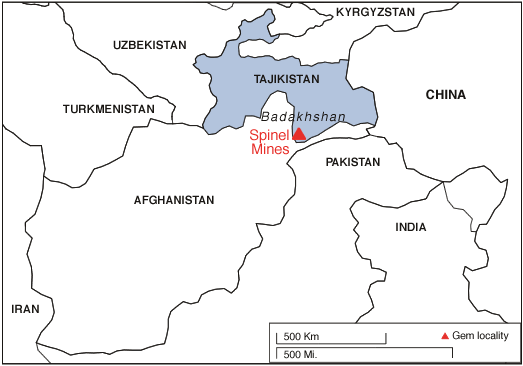 |
| Map of Central Asia, showing the location of the Badakhshan spinel mines. Illustration ©Richard W. Hughes |
Palagems.com Spinel Buying Guide
Introduction.
Throughout history, spinel has been confused with ruby. In part, this is because spinel is often found in the same deposits. Gem spinel is a magnesium aluminum oxide, while ruby (corundum) is an aluminum oxide. In deposits where both ruby and red spinel are found, spinel is typically more common than ruby. This is because, when both magnesium and aluminum are present, spinel grows. Only after the magnesium is exhausted, does ruby get a chance to crystallize. In addition, both ruby and red spinel owe their color to the same Cr+3 ion.
It is most likely that the famous Mogul spinels as described in Dr. Ball’s article above originated from mines long-since abandoned along the Amu Darya (Oxus) river that separates present-day Tajikistan from Afghanistan. The locality is just inside Tajikistan, about 47 km. south of Khorog, on the edge of the Pyandzeh river valley.
Fine examples of these “Badakhshan” spinels can be found in some of the most famous gem collections in the world. Perhaps the largest single grouping is in the Crown Jewels of Iran in Teheran. Others can be found in the British Crown Jewels in the Tower of London and the Kremlin in Moscow.
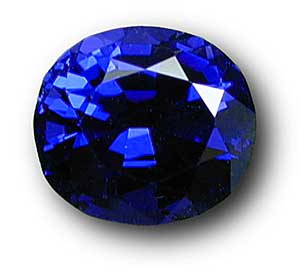 |
| Spinel colored by cobalt is one of the delights of the gem kingdom. Above is a particularly fine example. Photo: John McLean; Stone: Dr. Richard Bartholomeau |
Color. For red spinel, the finest colors tend to be similar to ruby, i.e. a rich, intense red similar to that of a red traffic signal. However, spinel tends to be a bit more of a brick red than ruby (which is slightly more purplish). Like all gems, the most-highly sought are those whose color is intense, while being not too light or dark. Prices decline as the color diminishes into either light pinks or “garnety” reds.
Orange spinels (also known as ‘flame’ spinels) can also be magnificent. Look for stones that are a rich orange without too many blackish overtones.
Sri Lanka rarely produces blue spinels colored by cobalt. Such “cobalt” blue spinels are highly sought after by collectors. The best pieces are an intense blue unique in the world of gems.
In addition to red, pink, orange and blue, spinel is found in a myriad of other colors. These are generally termed “fancy” spinels, and occur most often in shades of mauve, violet, purple and blue-green.
Clarity. In terms of clarity, spinel is often cleaner than ruby. However, the very finest reds are so rare that some clarity defect is almost always present (usually fractures). Included crystals are quite common in spinel. Many stones display natural iron-oxide stains in their fractures.
Cut. Due to the octahedral nature of spinel rough, the most common shape seen is the cushion. Rounds are also seen, as are other shapes, such as the emerald cut.
Prices. Red spinel has always resided in the shadow of ruby, with the result that prices are just a fraction of what the equivalent ruby would cost. Prices of intense cobalt-blue spinels can rival, or even exceed, those for the finest reds. Because synthetic spinels are often used for imitation birthstone rings, many people think “synthetic” when they hear the name “spinel.” This is unfortunate, for a fine gem spinel is one of nature’s most beautiful and rare treasures.
In fact, the main thing holding back greater recognition for spinel is rarity.
Stone Sizes. While faceted spinels of 100 carats or greater are known, top red or blue stones in sizes above five carats are rare. Fancy spinels in sizes up to 20 carats or more are generally available.
Crystal Habit. Spinel typically occurs as octahedra or twinned octahedra (macles), either well-formed or flattened. Specimens from Burma’s Mogok Stone Tract are often so perfect that they are mounted in jewelry as is. Such stones are termed nat thwe (‘spirit polished’).
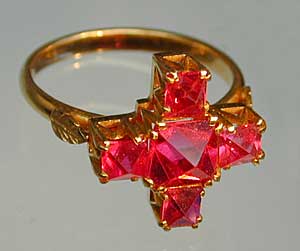 |
| This Burmese spinel ring features nat thwe spinel octahedra, which have received only light polishing. Photo: John McLean; Ring: William Larson Collection |
Name. The name spinel is believed to derive from the Latin word, spina, meaning “thorn,” perhaps in allusion to the pointed shape typical of spinel octahedra. In the past, spinel has been referred to as “balas ruby”, a reference to the mines of Badakhshan.
Sources. Today, fine spinels come from a handful of sources. The best red, pink and orange spinels originate from the rich gem gravels of Burma’s Mogok Stone Tract. The best blue and violet spinels are found in Sri Lanka (Ceylon). Gem spinel is also found in Vietnam, the Pamir mountains of Tajikistan, Tanzania and Madagascar. Black spinel is mined in Thailand (at Bo Ploi, Kanchanaburi).
Imitations. Synthetic spinel has been produced by the Verneuil process since about 1909. It is made in a variety of colors, some of which are not found in nature. Spinel has also been grown in Russia by the flux process in red and cobalt-blue colors.
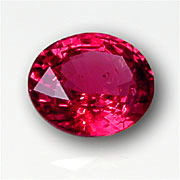 |
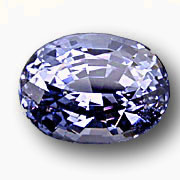 |
| This 1.73-ct. red spinel from Burma displays the intense crimson that has made spinel second only to ruby in the pantheon of red gems. Ask for Inventory #2405. Photo: John McLean; Gem: Pala International |
This 13.16-ct. rare violet spinel also comes from Burma. Ask for Inventory #417. Photo: John McLean; Gem: Pala International |
Here is a comparison of some of the properties of spinel and corundum:
| Spinel | Corundum (Ruby & Sapphire) | |
| Composition | MgAl2O4 | Al2O3 |
| Hardness (Mohs) | 8 | 9 |
| Specific Gravity | 3.63 | 4.00 |
| Refractive Index | 1.718 | 1.762–1.770 (0.008) Uniaxial (–) |
| Crystal System | Cubic | Hexagonal (trigonal) |
| Colors | Near colorless, red, pink, orange, green, blue, violet, purple. No yellow. | All (except an emerald-green) |
| Phenomena | Star (4 & 6 rays), cat’s eye | Star (6 & 12 rays) |
| Handling | No special care needed | No special care needed |
| Enhancements | Generally none; occasionally oiling, dying | Various, including heat, heat + flux healing, surface-diffusion, irradiation, oiling, dying, glass-infilling |
| Synthetic available? | Yes | Yes |
From this table, one can see how similar spinel and ruby are. Thus the confusion.
For historical information on Badakhshan spinels, as well as technical information about spinel, see also:
- The rubies and spinels of Afghanistan – A brief history by Richard W. Hughes
- Spinel compounds: Background and Historical Perspective by Kurt Sickafus and Richard W. Hughes